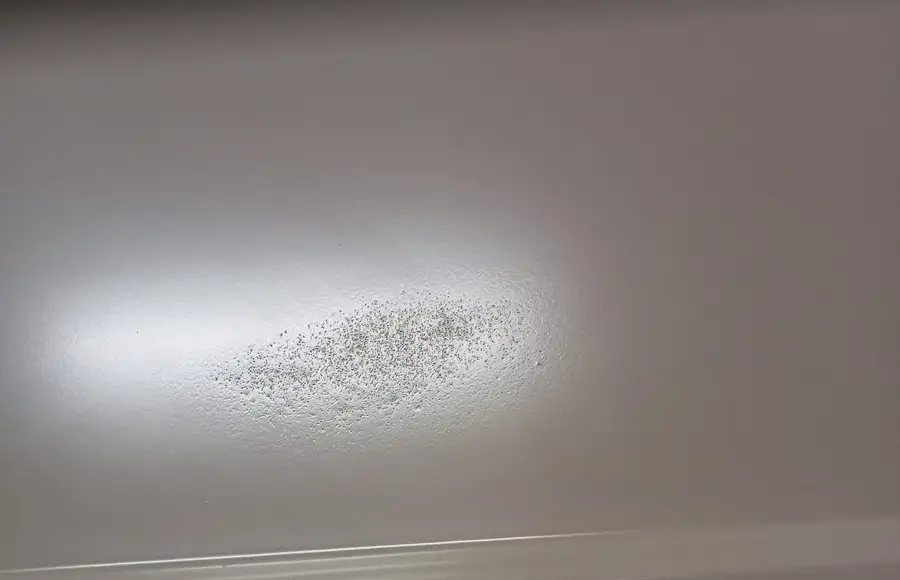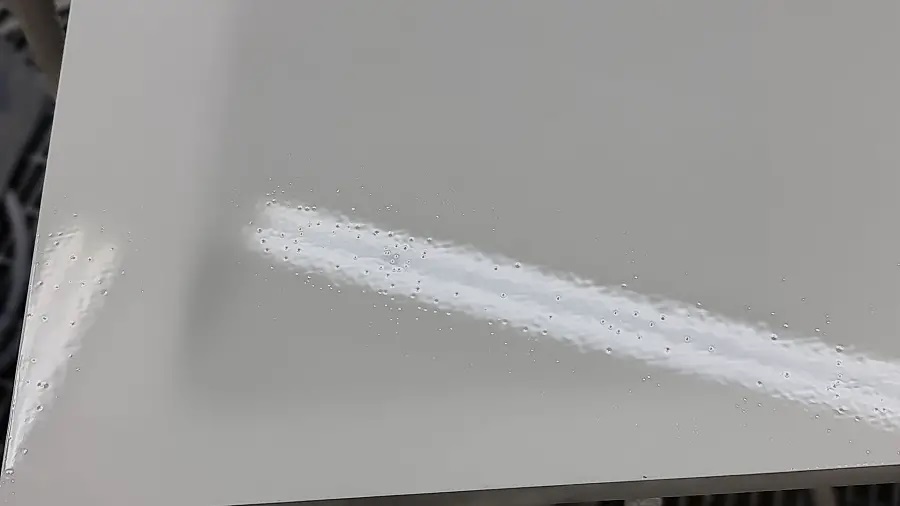Pitting in the lacquer or paint film sometimes occurs as a result of spraying finishing materials onto wood or MDF boards. The cause can be air in the pores of the wood or inside the MDF board, drying too quickly with solvent trapping in the film, spraying water-based materials after solvent-based ones or vice versa without the gun and the spray gun paths being thoroughly cleaned, oil escaping from the compressor, water from the compressor or on the spray gun paths. Even though each time it looks as if the varnish or paint film has been pricked with a thin needle, there are differences in the overall appearance of the defect depending on the cause of the defect. For example, regarding the picture below, my opinion is that the water from the compressor or hose got into the gun that was spraying the solvent based materials. Why water occurs in the compressor, what happens when drops of this water get into the spray gun, how oil from the compressor gets on the trails and how we solve such problems, in the following.

On what grounds have I said that, in the case of the above picture, the other defects are excluded
Air in the pores of wood. When the varnish or paint is too viscous and the pores are large, air fails to escape from the pores and is trapped in the film. The defect occurs after the first coat of primer has been applied and after his polishing small punctures are visible in the film. These usually follow the pattern formed by the pores.
The air in the MDF board. MDF is a material made from wood fibre. The board is softer on the inside and denser on the surfaces, where there is also a paraffin layer to protect it from moisture. More intense milling or sanding results in the softer side with higher absorbency. Air in this area tends to escape and as with air in the pores, can be trapped in the film. The punctures can be seen from place to place or spread over the whole surface, depending on how loose the plate is. Generally occurs in poor quality MDF. To look like in the picture above would require that the poor quality MDF has been sanded more in that area only. In that case in that area there would have been a very slight bump that would have reflected the light differently.
Fast drying with solvent trapping in the film. It happens especially in summer when it is very hot and the primer or varnish hardens before the solvent comes out. The very small droplets of solvent cause small pinprick-like holes to appear after sanding the primer or rough, unpleasant-to-touch surface on the varnish/paint. In this case, too, the punctures are spread unevenly over the entire surface.
Spraying water-based materials after solvent-based materials or vice versa. Solvent-based materials are not compatible with water-based materials and cannot be mixed. If a water-based varnish is sprayed after a solvent-based material (or vice versa) and the gun has not been thoroughly washed, solvent droplets may appear in the varnish which, when sprayed, are spread over the entire surface. The defect is visible as pinpricks spread unevenly over the entire surface. The same happens if the sprayed enclosure is not well ventilated before changing the material. Solvent vapour from the atmosphere falls onto the freshly painted surface and causes the pinpricks to appear. More information about such defects can be found at here.

Why water appears on spray paths and how to see the fault
The water in the compressor comes from the air. Compressing the air to the desired pressure causes water vapour to condense. The higher the humidity in the atmosphere, the more water collects in the compressor. The accumulated water must be removed from time to time and filters must be fitted along the route. The filters must be as efficient as possible to retain moisture. I have seen situations where the filter did not cope with the moisture in the air and water appeared in the small piece of hose between the filter and the gun.
When a drop of water hits the gun, the pressure in the air turns it into thousands of tiny droplets, just like it does with varnish or paint. If the finishing materials are solvent-based, there will be incompatibility between them and water. When tiny droplets of water fall on the film a separation occurs, just like when a drop of water falls into oil or petrol. Since the size is in the order of microns, it is not seen as a crater but as a pinhole. The defect appears clustered, many punctures gathered in one place, because the water does not arrive continuously in the gun but from time to time, making the defect appear random.
Compressor oil causes the same type of fault
The same can happen if you get oil on the trails. The oil may also come from the compressor. In the gun, the compressed air acts on the oil droplet and transforms it into many tiny droplets that fall onto the finished surface. Pitting occurs with both water-based and solvent-based products.
You can check for oil leaks by blowing air out of the gun, without varnish or paint, onto a suction cup or white absorbent wipe. If there is oil, small oily droplets will immediately show on the surface of the paper.
How to solve the problem
First of all we need to make sure that there is very little risk of water getting onto the trails. That means better filters and shorter routes. During periods of high humidity the compressor needs to be checked more often and the accumulated water removed.
The defect can be improved by adding an anti-crater additive to the varnish. It will not remove the water, but it will reduce the surface tension of the varnish and allow better stretching. The defect will not be so obvious and can be repaired more easily. Find such materials at professional wood varnish and paint suppliers.
If you already have prickly surfaces, first look for and remove the cause. To remedy, the surface should be sanded until the pitting is completely removed. Don't just sand superficially because subsequent coats will accentuate the defect. Sand the entire surface, not just locally. Then apply another coat of varnish or paint.
I hope you find the above information useful. As usual, additions are welcome. And if you have any questions or queries, please leave them in the space below. I'm sure I'll reply.



























Add comment